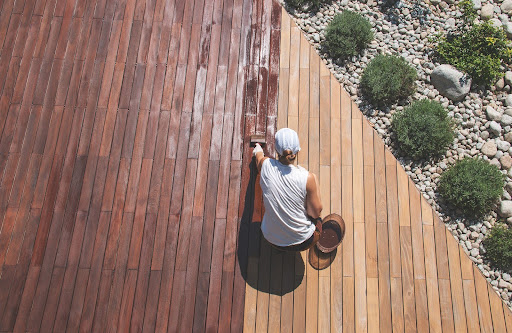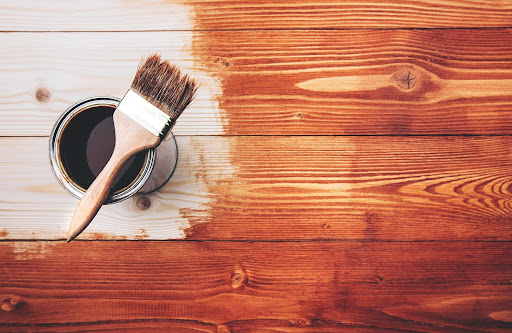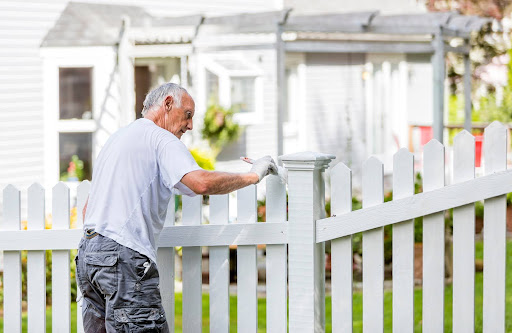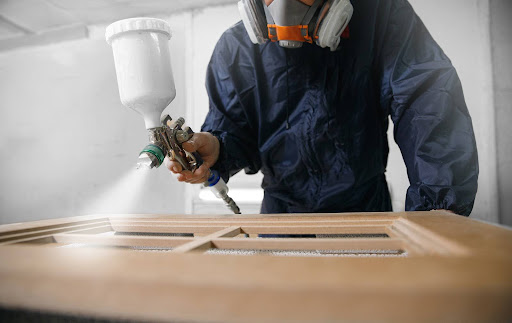
Staining wood and painting wood enhance the look and durability of wooden surfaces in your home. But how do they differ, and how do you know which one to choose?
What is Wood Staining?
This process involves applying a “stain,” or a semi-transparent liquid that seeps into the wood. This process gives the wood color while keeping its features, such as the grain, visible.
When staining wood, pigment is absorbed into wood fibers by soaking them in a solvent. The stain then sets and binds to the wood, saturating the wood with the pigment instead of creating a layer of color on top of it.
There are many different stain colors currently available on the market. However, the most common choices are in colors that resemble shades of timber, including mahogany and oak.
Whether you stain interior wood or exterior surfaces, it is best to use a protective clear top coat with the stain to maintain the wood’s durability and enhance its appearance.
When Should You Stain Wood?

Unlike paint, which creates a new layer on top of the wood, stain seeps into the wood. This helps preserve the lines and grain the wood naturally has while enhancing its appearance. This helps achieve a timeless and classic look for your home.
Staining is not limited to indoor walls and furniture. Staining exterior wood used in fences, decks, and siding offers numerous benefits.
Since it doesn’t fully cover the wood, it allows the wood to breathe. It also protects against termite damage, rot, and moisture damage, as it doesn’t tend to trap moisture under its layer.
Using stains instead of paint may also be a good choice, especially for wooden decks. Unlike paint, stains don’t create a slippery layer that may be hazardous when wet.
What is Painting Wood?
Painting wood involves applying paint, a colored liquid, to the surface. Unlike stain, which is semi-transparent, paint is usually opaque and made of different materials, such as water, pigment, and solids like sand and ground stone. It provides both color and a protective layer on surfaces.
Painting offers more flexibility than staining because it offers more variety in color choices. Before applying the paint, you must prepare the surface by sanding, cleaning, priming, and sealing. This process helps protect your wooden surface against moisture damage.
When Should You Paint Wood?

Painting is a good choice if you want the most protection for your wooden surfaces outside. The layer it creates on the surface of the wood becomes a barrier that may help protect surfaces from weather-related damage. It’s best used on wooden parts of the home that need to be more durable against weather elements, such as the trim or window frames.
Using paint also provides flexibility. If you want a home with a personality that you want to show off through color, paint is the right choice. You can choose from a wider array of pigments, colors, and finishes to personalize the appearance of your home.
Paint also helps cover up minor imperfections in your wooden surface. If you use a stain, such flaws easily show up and are often emphasized. Because paint forms a layer, these crevices, scratches, dents, and cracks are easier to hide.
Staining Vs Painting: How Are They Different?
Here are some key differences between staining and painting wooden surfaces in your home.
Durability
Stains penetrate wood, but since they are lighter, they must be reapplied more frequently than paint. This is especially true for exterior wooden surfaces like decks and fences. On the other hand, paint creates a thicker protective layer that lasts longer.
Maintenance
Touch-ups for stained surfaces are easier. Given how it provides pigment, it’s easy to blend seamlessly. Meanwhile, paint touch-ups usually need a full recoat to ensure the appearance stays uniform, making them more time-consuming and labor-intensive.
Application Considerations

The best temperature for staining wood is around 70° F. When staining pressure-treated wood, you must wait until the wood, not just the surface, is fully dry. This may take weeks to months.
Meanwhile, paint is more forgiving, but weather can still affect it. For best results, the temperature when applying paint should be at least 50° F. The temperature shouldn’t also go below 32° F for most paints to cure correctly. Colder temperatures may cause your paint to crack or peel. On the other hand, extreme heat may cause paint blistering or bubbling.
How to Decide Between Staining and Painting?
The decision to stain or paint wood usually depends on the homeowner’s preferences. However, several different factors may still affect their choice.
One of the most significant considerations is usually the final look of the wood. People typically use staining if maintaining the wood’s features is a top priority. Otherwise, they may choose solid colors instead and paint.
Another factor is protection and durability. Stain helps prevent moisture damage and internal wood rot. It also doesn’t peel or crack when applied. Meanwhile, a layer of paint creates a barrier to weather elements.
Frequently Asked Questions
What is the Best Type of Stain for Interior Wood Surfaces?
If you want to use stains on furniture or large wooden surfaces inside your home, you may use oil stains. These tend to dry longer but give the surface a more even finish. Oil-based stains also seep deeper into the wood, creating a richer, more saturated color.
What is the Best Type of Stain for Exterior Wood Surfaces?
If you want to use a stain on your deck, fence, or siding, solid stains are the best. These are designed to penetrate the wood, enhancing and showcasing the natural features. However, they don’t seep into the wood as deeply as a standard stain. They’re a good middle ground between regular stain and paint, and they may keep your outdoor wooden surfaces protected for up to seven years.
What is the Difference Between a Wood Varnish and a Stain?
While a stain penetrates the wood, a varnish is a clear or semi-clear substance that creates a protective layer on top of the wood. It’s usually used after staining, creating an extra protective layer on the wood.
Beauty and Durability
Deciding whether to stain wood or paint depends on your needs and wants. Both offer some degree of protection and enhance the look and feel of your home.Need help with painting or staining wood to enhance your home’s appearance? Queen City Painting, a Charlotte painting company, can help give your home a fresh coat of paint. Call us at 704-996-9266 or contact us online for a free quote today!
